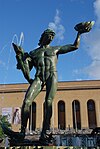Torslanda Airport
Torslanda Torslanda Flygfält | |
|---|---|
| Summary | |
| Airport type | Public |
| Serves | Gothenburg |
| Location | Torslanda, Sweden |
 | |
Largely demolished, no longer operational. | |
Torslanda Airport — (Swedish: Torslanda Flygplats or Torslanda Flygfält)[1] served the city of Gothenburg, Sweden, as its main airport from 1923 to 1977,[2] when the Gothenburg-Landvetter Airport was opened. The airport closed soon afterwards.
In 1969, an air traffic control tower was built on an adjacent hilltop as replacement for an older tower built in 1938.
Incidents
The airport[2] had been the site of a mishap on 23 December 1967 when a Douglas DC-6B operated by Sterling Airways carrying 55 passengers en route from Stockholm landed 3000 feet beyond the landing threshold.[3]
In a notable 1972 incident, a flight also from Torslanda en route to Stockholm was hijacked and diverted to Bulltofta airport outside the Swedish city of Malmö. Nine Croatians imprisoned nearby were traded for 500.000 SEK before flying to Madrid, Spain, before being captured by police.[4]

Use after the closure
The 1969 control tower remains (as of 2010) as one of the last artifacts of the airport. Most of the old airport was demolished in 1997, when the former runway paving were mainly removed.
Until 1995, Volvo housed its collection of historic vehicles in "The "Blue Hangar" (Den Blå Hangaren). Now they are located in the Volvo Museum, a few kilometres away.
In recent years, the original land from the Torslanda Airport has quickly redeveloped into a residential area known as Amhult, eventually to become a garden village with 900 new homes, a commercial centre, preschool and school.[5][6]
The former runways have partially been used for car testing by Volvo, for driver training and race car testing, and for model aircraft, until the runways were removed. An area is still used for storing ship containers. A golf course has been built over parts of the former runways. The road no 155 to Öckerö went a detour around the north-south runways. Around 1997 the road was rebuilt to go straight across the former runway. The terminal building remains and is used for a number of small shops.
Amhult
The name Amhult was popularised by William Edelman in 2001, when he was requested to build a futuristic population centre. The architect, Mikael Jansson, made a sketch of the centre but his sketch was never realized due to major measurement failures.[citation needed]
The construction headman, Frans Bergentall, claims that Mikael Janssons sketches were stolen from Simon Nestorovski, an investigation were started late in 2003, but no evidence was found. The case closed early in 2010.[citation needed]
References
- ^ "History - LFV". Archived from the original on June 12, 2008.
{{cite web}}: Unknown parameter|deadurl=ignored (|url-status=suggested) (help) - ^ a b "Landvetter Airport History". Spotters spot Gothenburg airports.
- ^ "Accident Description, Torslanda, 1967". Aviation-Safety.net.
- ^ "Hijacking Incident, Torslanda, 1972". Aviation-Safety.net.
- ^ "Growing young population demands new approach". DC Torlanda.
- ^ "Amhult 2 AB" (in Swedish). Retrieved 20 December 2010.

